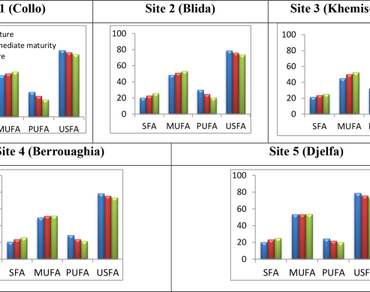Optimal ripening stage for maximizing fatty acid and tocopherol content, and antioxidant activity in Pistacia lentiscus fruit oil
Bakhti Koriba, Mohamed Harrat, Benalia Mohamed, Ben Ahmed Ziyad, Bombarda Isabelle, Gourine Nadhir, Yousfi Mohamed
Research Articles | Published: 31 January, 2024
First Page: 213
Last Page: 221
Views: 3015
Keywords: Ripe, Unripe, n Pistacia lentiscusn , Tocopherols, Fatty acids, Antioxidant activities
Abstract
The present work stands as an endeavor to uncover the ideal maturity stage of fruits harvesting in which they exhibit the maximum content of bioactive molecules such as essential fatty acids and tocopherols. The lipid content reaches its maximum value in mature fruit. The ratio of unsaturated fatty acids to saturated fatty acids in the oil of unripe fruit is twice that of ripe fruit. During maturity, the relative contents of oleic and palmitic fatty acids increase, while the relative content of linoleic and linolenic acids decrease. During the ripening process, the amounts of each tocopherol decrease, especially β-tocopherol, which decreases drastically. The statistical analysis showed that ripe fruit is characterized by the relatively highest contents of both C16:0 and C18:1 fatty acids, and at the same time, the relatively lowest content of C18:2 fatty acid compared to unripe fruit. Conversely, the highest antioxidant activity is obtained for unripe fruit, which is characterized by higher contents of α- and β-tocopherols. A significant decrease is noted in tocopherol content, accompanied by a decrease in antioxidant activity. The highest tocopherol content in the fruit’s oil is exclusively obtained at the initial ripening stage (immature). Therefore, harvesting fruit at this stage is highly recommended. The obtained result provides a better understanding of the use of the oils based on the ripeness of these fruits for various industrial applications.

References
Ait Mohand B, EL Antari A, Benkhalti F (2022) Influence of maturity stage on chemical composition and antioxidant activity of Pistacia lentiscus seed oils. Arab J Med Aromatic Plants 8(1):171–186. https://doi.org/10.48347/IMIST.PRSM/ajmap-v8i1.27039
Baccouri O, Guerfel M, Baccouri B, Cerretani L, Bendini A, Lercker G, Zarrouk M, Daoud Ben Miled D (2008) Chemical composition and oxidative stability of Tunisian monovarietal virgin olive oils with regard to fruit ripening. Food Chem 109(4):743–754. https://doi.org/10.1016/j.foodchem.2008.01.034
Boudieb K, Ait Slimane-Ait Kaki S, Amellal-Chibane H (2019) Effect of maturation degree on the fixed oil chemical composition, phenolic compounds, mineral nutrients and antioxidant properties of Pistacia lentiscus L. fruits. Notulae Botanicae Horti Agrobotanici Cluj-Napoca 47(3):836–847. https://doi.org/10.15835/nbha47311534
Charef M, Yousfi M, Saidi M, Stocker P (2008) Determination of the fatty acid composition of Acorn (Quercus), Pistacia lentiscus seeds growing in Algeria. J Am Oil Chem Soc 85(10):921–924. https://doi.org/10.1007/s11746-008-1283-1
Dag A, Kerem Z, Yogev N, Zipori I, Lavee S, Ben-David E (2011) Influence of time of harvest and maturity index on olive oil yield and quality. Sci Hort 127(3):358–366. https://doi.org/10.1016/j.scienta.2010.11.008
Emmerie A, Engel CHR (1939) Colorimetric estimation of toeopherol, vitamin E 3. Blood-serum. Rec trav chim PaysBos. 88:895–902
Haouli A, Seridi R, Djemli S, Bourdjiba O (2015) Contribution to the analysis of Pistacia lentiscus extracted oil. Am Eurasian J Agric Environ Sci 15(6):1075–1081. https://doi.org/10.5829/idosi.aejaes.2015.15.6.94110
Harrat M, Benalia M, Gourine N, Yousfi M, Metabolism (2018) Variability of the chemical compositions of fatty acids, tocopherols and lipids antioxidant activities, obtained from the leaves of Pistacia lentiscus L. growing in Algeria. Mediterr J Nutr Metab 11(2):199–215. https://doi.org/10.3233/MNM-18198
Harrat M, Gourine N, Válega M, Yousfi M (2020) Seasonal variability of chemical composition and antioxidant activity of lipids (fatty acids and tocopherols) from the leaves of Pistacia lentiscus L. J Food Measurementand Charact 14(4):1939–1956. https://doi.org/10.1007/s11694-020-00441-0
Khiari M, Kechrid Z, Klibet F, Elfeki A, Md SS, Krishnaiah D (2018) NiO nanoparticles induce cytotoxicity mediated through ROS generation and impairing the antioxidant defense in the human lung epithelial cells (A549): preventive effect of Pistacia lentiscus essential oil. Toxicol Rep 5:480–488. https://doi.org/10.1016/j.toxrep.2018.03.012
Lozano YF, Mayer CD, Bannon C, Gaydou EM (1993) Unsaponifiable matter, total sterol and tocopherol contents of avocado oil varieties. J Am Oil Chemists’ Soc 70(6):561–565. https://doi.org/10.1007/BF02545319
Mansouri F, Ben moumen A, Belhaj K, Richard G, Fauconnier M-L, Sindic M, Caid HS, Elamrani A (2018) Effect of crop season on the quality and composition of extra virgin olive oils from Greek and Spanish varieties grown in the oriental region of Morocco. Emirates J Food Agric 30(7):549–562. https://doi.org/10.9755/ejfa.2018.v30.i7.1738
Mezni F, Labidi A, Msallem M, Boussaid M, Khouja M, Khaldi A (2014) Influence of harvest date on fatty acid composition and antioxidant activity of Pistacia lentiscus L. edible oils. J Mater Environ Sci 5(6):1703–1708
Motilva M-J, Romero M-P (2010) In: Chap. 7 - The effect of the ripening process of the olive fruit on the chlorophyll and carotenoid fractions of drupes and virgin oils. In: Preedy VR, Watson RR (ed). Olives and Olive Oil in Health and Disease Prevention, San Diego. pp 59–68. https://doi.org/10.1016/B978-0-12-374420-3.00007-3
Remila S, Atmani-Kilani D, Delemasure S, Connat J-L, Azib L, Richard T, Atmani D (2015) Antioxidant, cytoprotective, anti-inflammatory and anticancer activities of Pistacia lentiscus (Anacardiaceae) leaf and fruit extracts. Eur J Integr Med 7(3):274–286. https://doi.org/10.1016/j.eujim.2015.03.009
Rotondi A, Bendini A, Cerretani L, Mari M, Lercker G, Toschi TG (2004) Effect of olive ripening degree on the oxidative stability and organoleptic properties of cv. Nostrana Di Brisighella extra virgin olive oil. J Agric Food Chem 52(11):3649–3654. https://doi.org/10.1021/jf049845a
Yi T, Wen J, Golan-Goldhirsh A, Parfitt DE (2008) Phylogenetics and reticulate evolution in Pistacia (Anacardiaceae). Am J Bot 95(2):241–251. https://doi.org/10.3732/ajb.95.2.241
Youssef NB, Leïla A, Youssef O, Mohamed SN, Nizard D, Chedly A, Mokhtar Z (2012) Influence of the site of cultivation on chetoui olive (Olea europaea L.) oil quality. Plant Prod Sci 15(3):228–237. https://doi.org/10.1626/pps.15.228
Author Information
Laboratoire des Sciences Fondamentales (LSF), University Amar Teliji of Laghouat, Laghouat, Algeria